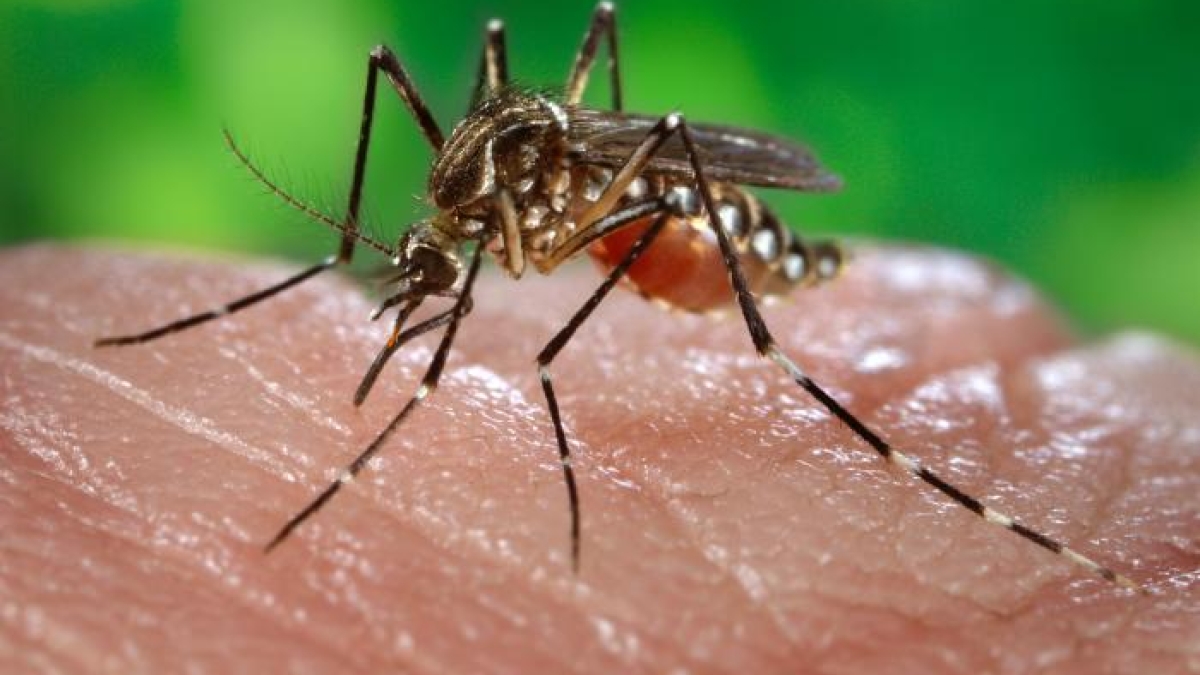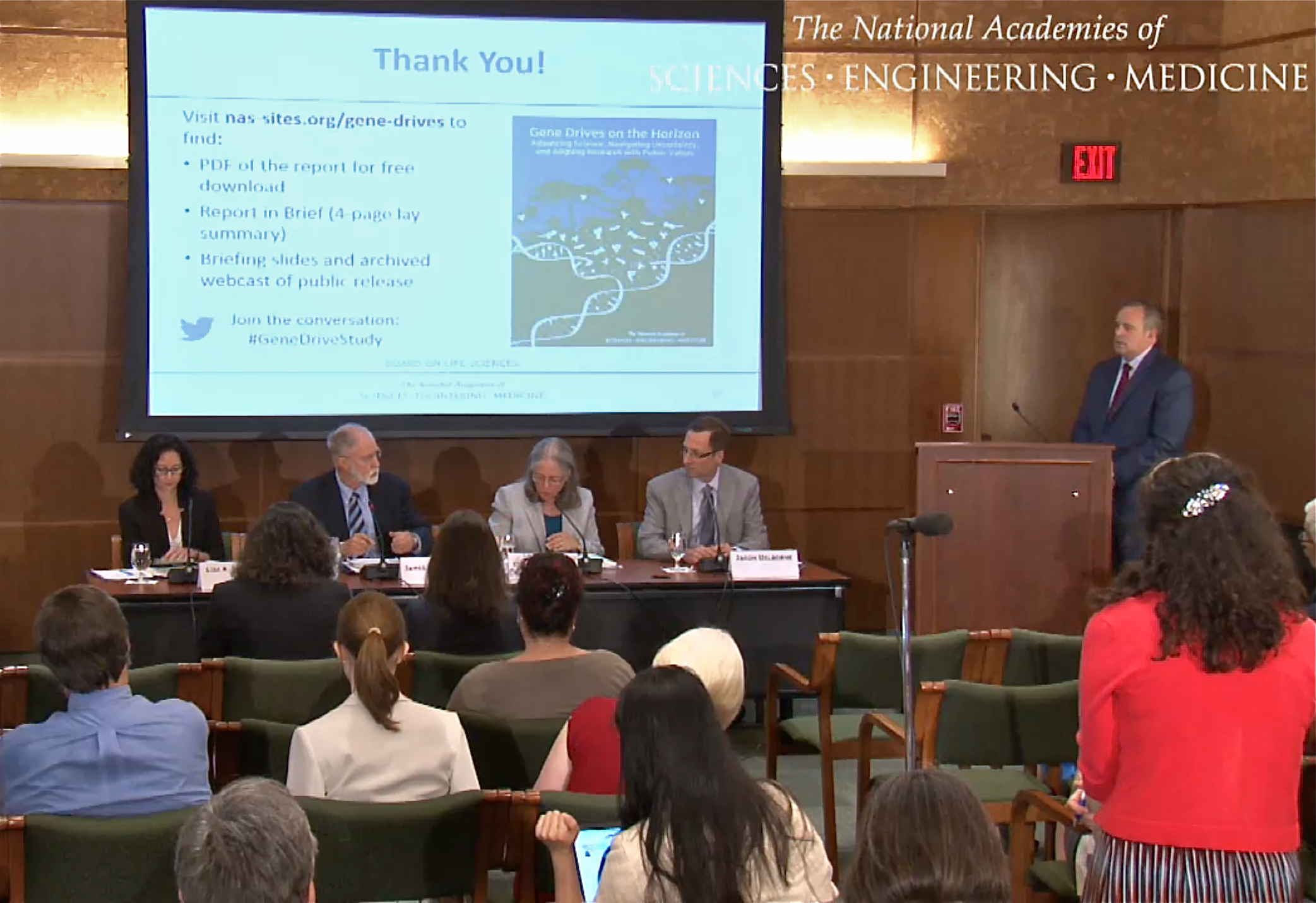New report calls for more research and robust assessment of gene drives

An Aedes aegypti mosquito. Gene drives offer the promise of eliminating disease-transmitting mosquitoes, but a national committee convened to determine best research practices said Wednesday that more research is needed before gene-drive-modified organisms are released into the wild.
The potential of a gene drive to do good is great. For example, it could be used to eliminate infectious diseases such as malaria or the Zika virus. But it also could be used to wipe out specific species, raising ethical issues.
Because it is such a powerful technology and because questions remain about its use, caution should be used as we move forward in the development of gene drives, according to a blue-ribbon committee of experts.
The committee, funded by the National Institutes of Health (NIH) and the Foundation for the NIH and co-chaired by Arizona State University professor James P. Collins, said the uncertainty posed by this fast-moving field of study emphasizes the need for informed decisions about its development and application.
The committee recommends a collaborative, multidisciplinary and cautionary approach to research on and governance of gene drive technologies.
“The science and technology associated with gene drives is developing very quickly,” said Collins, the Virginia M. Ullman professor of Natural History and the Environment in the School of Life Sciences at ASU. “But before gene-drive-modified organisms are put into the environment, our committee urges caution — a lot more research is needed to understand the scientific, ethical, regulatory and social consequences of releasing such organisms.”
Gene drives are systems of “biased inheritance” that enhance a genetic element's ability to pass from parent organism to offspring. With the advent of new, more efficient and targeted gene-editing techniques such as CRISPR/Cas9, gene modifications can, in principle, be intentionally and quickly spread throughout a population of living organisms.
They could be used to address public-health threats, conservation-related issues, agricultural pests and other challenges. For example, gene drives might be developed to modify organisms that carry infectious diseases such as dengue, malaria and Zika. In agriculture, a gene drive might be used to control or alter organisms that damage crops or carry crop disease.
On the other hand, some gene-drive-modified organisms might lead to unintended consequences, such as the unintentional disruption of a non-target species or the establishment of a second, more resilient invasive species.
The gaps in our understanding of the biology of gene drives and the potential effects of gene-drive-modified organisms on the environment are fundamental considerations in the development and release of gene-drive-modified organisms, the report states. Laboratory and field research is needed to refine gene drive mechanisms and better understand how gene drives work, from the molecular level through species and ecosystem levels.
Meeting this need will require collaboration among multiple fields of study including molecular biology, population genetics, evolutionary biology and ecology, according to the report. In addition, open-access, online data banks and standard operating procedures should be established to share information and guide research design.
The committee recommended a phased testing approach to gene drive research to guide research from the laboratory to the field. Because the goal of using a gene drive is to spread genetic information throughout a population rapidly, it is difficult to anticipate its impact and important to minimize the potential for unintended consequences. Phased testing can facilitate evidence-based decision making, with every step promoting careful study and evaluation.
ASU professor James P. Collins (second from left at table) co-chaired the national committee looking at best practices and recommendations on gene drives. The committee delivered its report Wednesday in a live webcast from Washington, D.C., shown here in a screenshot.
Each proposed field test or environmental release of a gene-drive-modified organism should be subject to robust ecological risk assessment before being approved. These assessments, which take into account the gene drive’s characteristics, effects on humans and the environment, and local values and governance, are a key tool for determining a gene drive’s impacts, the report states. As of May 2016, no ecological risk assessment has been conducted for a gene-drive-modified organism.
Public engagement can help frame and define the potential harms and potential benefits of using a gene-drive-modified organism, and must be built into risk assessment and decision-making. The outcomes of public engagement may be as crucial as scientific outcomes in making decisions about whether to release a gene-drive-modified organism into the environment.
The report recommends that the governing authorities, including research institutions, funders and regulators, develop and maintain clear policies and mechanisms for how public engagement will factor into research, ecological risk assessments and public-policy decisions about gene drives.
“Responsible research on gene drives and gene drive technology requires consideration of values and public engagement throughout the process,” said committee co-chair Elizabeth Heitman, associate professor of medical ethics, Vanderbilt University Medical Center’s Center for Biomedical Ethics and Society.
The study was sponsored by the National Institutes of Health, the Foundation for the National Institutes of Health (FNIH) and the National Academy of Sciences Biology and Biotechnology Fund. The Defense Advanced Research Projects Agency and the Bill & Melinda Gates Foundation provided funding to NIH and FNIH, respectively, in support of this study. The study was completed under the auspices of the National Academies of Sciences, Engineering and Medicine.
More on gene drives
- ASU professor James P. Collins answers questions about gene drives' potential risks and rewards.
- Find the committee's full report here.
More Science and technology

ASU-led space telescope is ready to fly
The Star Planet Activity Research CubeSat, or SPARCS, a small space telescope that will monitor the flares and sunspot activity…

ASU at the heart of the state's revitalized microelectronics industry
A stronger local economy, more reliable technology, and a future where our computers and devices do the impossible: that’s the…

Breakthrough copper alloy achieves unprecedented high-temperature performance
A team of researchers from Arizona State University, the U.S. Army Research Laboratory, Lehigh University and Louisiana State…


